Most
of the English lexicon is constituted by word which have several
morphemes. (75 % engl. Words – polymorphemic words).
In
ME most English vocabulary arises grows by making new lexemes out of
old one, by adding an affixation to previously existing forms
altering their words class and meaning by combining the existing
words (basis) to produce compounds: derivatives, derived words
(friendly
– unfriendly, teapot, bag bone).
The
contribution of word formation to the grows and development of
English lexicons is second to none, although a great deal belong to
borrowing and semantic derivation.
-
A
complex word structure – the result of different word-formation
process (illegal, discouraging, uninteresting) -
A
complex word structure may be connected with borrowing and further
identification of certain morpheme in the system of language
recipient.
Moreover
similar international structure may be the result of different word
formation process. E.g. discouraging
– discourage + ing; uninteresting – un + interesting
– morphologically(structurally) they are the same.
The
morphemic analyses and derived analyses they are differ in the aims
and basic elements.
To
eye – monomorphic (root word) It’s a derived word.A
morpheme
– the smallest meaningful language unit. Morphemes
may be classified:
-
from
the semantic point of view.
Semantically morphemes fall into two classes:-
root-morphemes
— is the lexical nucleus of a wщrd, it has an individual lexical
meaning shared by no other morpheme of the language. The
root-morpheme is isolated as the morpheme common to a set of words
making up a word-cluster, for example the morpheme teach-in
to teach,
teacher, teaching, theor- in
theory,
theorist, theoretical, etc.
-
non-root
or affixational
morphemes
include inflectional morphemes or inflections and affixational
morphemes or affixes. Roots and affixes make two distinct classes of
morphemes due to the different roles they play in word-structure.
Roots
and affixational morphemes are generally easily distinguished and the
difference between them is clearly felt as, e.g., in the words
helpless,
handy, blackness, Londoner, refill, etc.:
the root-morphemes help-,
hand-, black-, London-, -fill are
understood as the lexical centres of the words, as the basic
constituent part of a word without which the word is inconceivable.
Affixes
are classified into prefixes
and suffixes:
a prefix precedes the root-morpheme, a suffix follows it.
Affixes besides the meaning proper to root-morphemes possess the
part-of-speech meaning and a generalised lexical meaning.
-
Structurally morphemes fall into three types:
-
A
free
morpheme
is defined as one that coincides with the stem or a word-form. A
great many root-morphemes are free morphemes, for example, the
root-morpheme friend
—
of the noun friendship
is
naturally qualified as a free morpheme because it coincides with
one of the forms of the noun friend. -
A
bound
morpheme
occurs only as a constituent part of a word. Affixes are,
naturally, bound morphemes, for they always make part of a word,
e.g. the suffixes -ness,
-ship, -ise (-ize), etc.,
the prefixes un-,dis-,
de-, etc.
(e.g. readiness, comradeship, to activise; unnatural, to displease,
to decipher).
-
Many
root-morphemes also belong to the class of bound morphemes which
always occur in morphemic sequences, i.e. in combinations with ‘
roots or affixes. All unique roots and pseudo-roots are-bound
morphemes. Such are the root-morphemes theor-
in
theory,
theoretical, etc.,
barbar-in
barbarism,
barbarian, etc.,
-ceive
in
conceive, perceive,
etc.
-
Semi-bound
(semi-free)
morpheme
are morphemes that can function in a morphemic sequence both as an
affix and as a free morpheme. For example, the morpheme well
and
half
on
the one hand occur as free morphemes that coincide with the stem and
the word-form in utterances like sleep
well, half an hour,” on
the other hand they occur as bound morphemes in words like
well-known,
half-eaten, half-done.Speaking
of word-structure on the morphemic level two groups of morphemes
should be specially mentioned.
To
the
first
group
belong morphemes of Greek and Latin origin often called combining
forms,
e.g. telephone,
telegraph, phonoscope, microscope, etc.
The morphemes tele-,
graph-, scope-, micro-, phone- are
characterised by a definite lexical meaning and peculiar stylistic
reference: tele-
means
‘far’, graph-
means
‘writing’, scope
— ’seeing’, micro-
implies
smallness, phone-
means
’sound.’ Comparing words with tele-
as
their first constituent, such as telegraph,
telephone, telegram one
may conclude that tele-
is
a prefix and graph-,
phone-, gram-are
root-morphemes. On the other hand, words like phonograph,
seismograph, autograph may
create the impression that the second morpheme graph
is
a suffix and the first — a root-morpheme. These morphemes are all
bound root-morphemes of a special kind and such words belong to words
made up of bound roots. The fact that these morphemes do not possess
the part-of-speech meaning typical of affixational morphemes
evidences their status as roots.
The
second
group
embraces
morphemes occupying a kind of intermediate
position, morphemes that are changing their class membership.
According
to the number of morphemes words are classified into monomorphic
and
polymorphic.
Monomorphiс
or root-words consist of only one root-morpheme, e.g. small,
dog, make, give, etc.
Pоlуmоrphiс
words according to the number of root-morphemes are classified into
two subgroups:
-
polyradical
words, i.e. words which consist of two or more roots. Polyradical
words fall into two types:
1)
polyradical
words
which consist of two or more roots with no affixational morphemes,
e.g. book-stand,
eye-ball, lamp-shade, etc.
and
2)
words which contain
at least two
roots
and one
or more
affixational
morphemes,
e.g. safety-pin,
wedding-pie, class-consciousness, light-mindedness, pen-holder, etc.
-
Monoradical
words fall into two subtypes:
radical-suffixal
words, i.e. words that consist of one root-morpheme and one or more
suffixal morphemes, e.g. acceptable,
acceptability, blackish, etc.;
2)radical-prefixal
words, i.e. words that consist of one root-morpheme and a prefixal
morpheme, e.g. outdo,
rearrange, unbutton, etc.
and 3) prefixo-radical-suffixal,
i.e. words which consist of one root, a prefixal and suffixal
morphemes, e.g. disagreeable,
misinterpretation, etc.
Three
types of morphemic segmentability of words are distinguished:
complete,
conditional
and
defective.
Complete
segmentability is characteristic of a great many words the morphemic
structure of which is transparent enough, as their individual
morphemes clearly stand out within the word lending themselves easily
to isolation.
Conditional
morphemic segmentability characterises words whose segmentation into
the constituent morphemes is doubtful for semantic reasons. The
morphemes making up words of conditional segmentability thus differ
from morphemes making up words of complete segmentability in that the
former do not rise to the full status of morphemes for semantic
reasons and that is why a special term is applied to them in
linguistic literature: such morphemes are called pseudo-morphemes
or quasi-morphemes.
Defective
morphemic segmentability is the property of words whose component
morphemes seldom or never recur in other words. One
of
the component morphemes is a unique morpheme in the sense that it
does not, as a rule, recur in a different linguistic environment. A
unique morpheme is isolated and understood as meaningful because the
constituent morphemes display a more or less clear denotational
meaning. The morphemic analysis of words like cranberry,
gooseberry, strawberry shows
that they also possess defective morphemic segmentability: the
morphemes cran-,
goose-, straw- are
unique morphemes.
Morphemic
analyses – the
aim is to state the number and type of morphemes the word possess.
The
procedure generally employed for the purposes of segmenting words
into the constituent morphemes is the method of Immediate
and Ultimate
Constituents.
This method is based on a binary principle, i.e. each stage of the
procedure involves two components the word immediately breaks into.
At each stage these two components are referred to as the Immediate
Constituents (ICs). Each IC at the next stage of analysis is in turn
broken into two smaller meaningful elements. The analysis is
completed when we arrive at constituents incapable of further
division, i.e. morphemes. In terms of the method employed these are
referred to as the Ultimate Constituents (UCs). For example the noun
friendliness
is
first segmented into the IC friendly
recurring
in the adjectives friendly-looking
and
friendly
and
the -ness
found
in a countless number of nouns, such as happiness,
darkness, unselfishness, etc.
The IC -ness
is
at the same time a UC of the noun, as it cannot be broken into any
smaller elements possessing both sound-form and meaning. The IC
friendly
is
next broken into the ICs friend-and
-ly
recurring
in friendship,
unfriendly, etc.
on the one hand, and wifely,
brotherly, etc.,
on the other. Needless to say that the ICs friend-and
-ly
are
both UCs of the word under analysis.
The
morphemic analysis according to the IC and UC may be carried out on
the basis of two principles: the so-called root
principle
and
the
affix principle.
According to the affix
principle
the segmentation of the word into its constituent morphemes is based
on the identification of an affixational morpheme within a set of
words; for example, the identification of the suffixational morpheme
-less
leads
to the segmentation of words like useless,
hopeless, merciless, etc.,
into the suffixational morpheme -less and the root-morphemes within a
word-cluster; the identification of the root-morpheme agree- in the
words agreeable,
agreement, disagree makes
it possible to split these words into the root -agree-
and
the affixational morphemes -able,
-ment, dis-. As
a rule, the application of one of these
11.
Derivational analyses.
The
nature, type and arrangement of the ICs of the word is known as its
derivative
structure.
According to the derivative structure all words fall into two big
classes: simple,
non-derived words and complexes
or derivatives.
Simplexes
are words which derivationally cannot’ be segmented into ICs.
Derivatives
are words which depend on some other simpler lexical items that
motivate them structurally and semantically, i.e. the meaning and the
structure of the derivative is understood through the comparison with
the meaning and the structure of the source word.
The
basic elementary units of the derivative structure of words are:
derivational
bases,
derivational
affixes
and
derivational
patterns.
The relations between words with a common root but of different
derivative structure are known as derivative
relations.
The derivative and derivative relations make the subject of study at
the
derivational
level
of analysis;
it aims at establishing correlations between different types of
words, the structural and semantic patterns words are built on, the
study also enables one to understand how new words appear in the
language.
Derivational
base: is
defined as the constituent to which a rule of word-formation is
applied. Structurally derivational bases fall into three classes: 1)
bases
that coincide
with
morphological
stems
of different degrees of complexity, e.g. dutiful,
dutifully;
day-dream,
to day-dream, daydreamer.
Derivationally
the stems may be:
-
simple,
which consist of only one, semantically non motivated constituent
(pocket,
motion, retain, horrible).
b) derived
stems are semantically and structurally motivated, and are the
results of the application of word-formation rules (girl
– girlish, to weekend, to daydream)
c) compound
stems are always binary and semantically motivated (match-box,
letter-writer)
2)
bases
that coincide with
word-forms;
e.g. paper-bound,
unsmiling,
unknown.
This class of bases is confined to verbal word-forms
— the
present and the past participles.
3)
bases
that coincide with
word-grоups
of different degrees of stability, e ,g. second-rateness,
flat-waisted,
etc. This class is made of word-groups. Bases of this kind are most
active with derivational affixes in the class of adjectives and
nouns, e.g. blue-eyed,
long-fingered, old-fashioned, do-gooder, etc.
Derivational
affixes: Derivational
affixes are ICs of numerous derivatives in all parts of speech.
Derivational affixes possess two basic functions: 1)
that
of stem-building
and 2)
that
of word-building.
In most cases derivational affixes perform both
functions
simultaneously. It is true that the part-of-speech meaning is proper
in different degrees to the derivational suffixes and prefixes. It
stands out clearly in derivational suffixes but it is less evident in
prefixes; some prefixes lack it altogether. Prefixes like en-,
un-, de-,
out-,
be-,
unmistakably possess the part-of-speech meaning and function as verb
classifiers. The prefix over-evidently
lacks the part-of-speech meaning and is freely used both for verbs
and adjectives, the same may be said about non-,
pre-, post-.
Derivational
patterns: A
derivational
pattern
is a regular
meaningful arrangement, a structure that imposes rigid rules on the
order and the nature of the derivational bases and affixes that may
be brought together.
There
are two types of DPs — structural that specify base classes and
individual affixes, and structural-semantic that specify semantic
peculiarities of bases and the individual meaning of the affix. DPs
of different levels of generalisation signal: 1)
the
class of source unit that motivates the derivative and the direction
of motivation between different classes of words; 2)
the
part of speech of the derivative; 3)
the
lexical sets and semantic features of derivatives.
Соседние файлы в предмете [НЕСОРТИРОВАННОЕ]
- #
- #
- #
- #
- #
- #
- #
- #
- #
- #
- #
Morphology
Morphology Definition: the analysis of word structure.
Inflectional vs Derivational Morphology studies the ways in which morphemes are used to express grammatical contrasts in sentences studies the principles/rules governing the construction of new words
Inflectional Morphology Morpheme — unit of meaning which may be represented by one or more allomorphs Examples: cat-s sing-ing good-ness un-happi-ly act-ive act-iv-ity in-act-ive in-act-iv-ity
Kinds of Morphemes 1. Roots/stems/Free Morphemes 1. Affixes/Bound Morphemes
Affixes/Bound Morphemes Represent grammatical or relational meanings Types of Affixes Prefixes — come before the stem Un-happy Suffixes — come after the stem Happi-ness Infixes — come within the stem (English doesn’t use these) Tagalog (Philippine language) examples of infixes Stem: -basa- which means «read» /bumasa ako nan libro/ read I the book I read the book. (past tense) /binasa an libro/ was read the book The book was read. Bontoc (Philippine language) examples of infixes /fikas/ «strong» /fumikas/ «He is becoming strong» /bato/ «stone» /bumato/ «He is becoming stone» /fusul/ «enemy» /fumusul/ «He is becoming enemy
Allomorphs Definition: alternative forms which carry the same meaning but have different phonological shape.
Allomorphs • • Examples from English /-iz/ class/classes (following sibilants s, c, z, j) /-s/ cat/cats (following nonsibilant voiceless consonants) /-z/ tub/tubs (following nonsibilant voiced consonants) /-z/ bee/bees (following vowels) Allomorphs in “Plural” Morpheme (/-iz/, /-s/, /-z/)
Morphologically Characterized Language Types Isolating Languages Agglutinating Languages Fusional Languages Polysynthetic Languages
Two Questions Used to Classify Languages Morphologically 1. Does a word divide into smaller meaningful parts? 2. Does each component express a single meaning?
Isolating Languages Question 1 = NO Languages that use undividable words, but have strict rules of word order to keep the grammatical meanings of things clear. Also know as “analytic languages “ Included are Chinese, Indonesian, Pidgins and Creoles.
Isolating languages Mandarin Chinese examples /wo gang yao gei ni na yi bei cha/ I just want for you bring one cup tea «I am about to bring you a cup of tea. » /xia yu/ down rain «It was/is/will be raining»
Agglutinating Languages Questions 1 = Yes, 3=Yes • Words can be divided into morphemes • Each morpheme expresses a separate grammatical meaning Included are Finnish, Turkish, Japanese, Tamil, etc.
Agglutinating Languages Turkish example from the stem /ol-/ meaning die ol-mek «to die» stem + infinitive ol-dur-mek «to kill» st+Cause+infinitive ol-dur-me-mek «to not kill» st+cause+neg+infin ol-dur-ul-mek «to be killed» st+cause+Pass+infi ol-dur-ul-me-mek «to not be killed» st+cau+pas+neg+inf oldurebilemeseydim «I wish I hadn’t been able to kill» ol -dur -ebil -eme -sey -d -im die cause able not wish past I
Fusional Languages Questions 1 = Yes, 3=No • Words can be divided into morphemes, • Morphemes can express more than one grammatical meaning Also know as “inflectional languages “ Included are Indo-European and Afro-Asiatic languages. .
Fusional Languages Latin Example Declensions — variations on nouns (e. g. man, men, man’s, men’s). Conjugations — variations on verbs (e. g. sing, sang, sung). e pluribus unum pluribus many – plural/dative case “Out of many, one”
Systems of Inflectional Morphology Verb tenses — mark time and person English example: 6 persons and past, present, future, etc Noun tenses — mark time on nouns Japanese example: shiroi(white), shirokatta(was white), and shirkute(being white) Noun cases — mark gramatical role in sentence Finnish example: fifteen cases nominative (subject) ablative (from) allative (to) essive (as) partitive (part of) translative (change to) abessive (without) accusative (object) instructive (by) inessive (in) comitative (with) elative (out of) genitive (possessive) illative (into) adessive (on)
Latin Declension of “Friend” and “Field” Case Singular Plural Nominative amicus amici ager agri (subjective) (uh-mee-kus) (uh-mee-kee) (uh-gehr) (uh-gree) Genitive amici amicorum agri agrorum (possessive) (uh-mee-kee) (uh-mee-korum) (uh-gree) (uh-gro-rum) Dative amico amicis agro agris (indirect object) (uh-mee-ko) (uh-meekees) (uh-gro) (uh-grees) Accusative amicum amicos agrum agros (direct object) (uh-meekoom) (uh-mee-kos) (uh-grum) (uh-gros) Ablative amico amicis agro agris (uh-meekees) (uh-gro) (uh-grees) (from the. . (uh-mee-ko) =adverb)
Polysynthetic Languages A small group of languages that have complex multi-morpheme words that carry a sentence-worth of information. Included are Basque and many Amerindian languages. Also know as “amalgamating languages” These languages are usually very difficult to learn, unless you are brought up with them. The Basques joke that they are immune to the Devil because he couldn’t learn their language!
Polysynthetic Languages Chukchi Example 1 st person- big- head- aching I have a bad headache. Ojibwe Example • baataanitaaanishinaabemong = «being able to speak Ojibwe. » • ngiinitaaozhibii’amaadimin = «we used to write to each other. »
Derivational Morphology
Processes of New Word Formation • Prefixation «disobey“ • Suffixation «kindness» • Conversion — a word changes its class without changing its form «carpet (n. )» becomes «carpet (v. )» • Compounding — two free bases/stems are added together “blackbird» • Reduplication — «goody-goody» «wishy-washy» «teeny-weeny» • Clippings — «ad» «telly» «flu» • Acronyms — «NATO» «DJ» «VIP» • Blends — «Brunch» from Breakfast and Lunch «Telex» from teleprinter and exchange
Defining “Word” Five ways to identify a word 1. Potential Pauses — consistent pauses in speech when sentence spoken slowly. 2. Indivisibility — where additional words added? They will be added between words, not within them. 3. Minimal Free Forms — Bloomfield defined as: the smallest units of speech that can meaningfully stand on their own. 4. Phonetic Boundaries — in languages with consistent and uniform stress (for example Welsh on the last syllable) can identify the end of each word by stress. 5. Semantic Units — in some sentences, words constitute units of meaning (Dog bites man. ) However, in other sentences, words are not clearly separate units of meaning (I switched on the light. ) «the» doesn’t have a clear separate meaning, and «switched on» requires two words to convey meaning.
Word Classes Definition: groups based on the way words are used/behave in language Example from English nouns pronouns adjectives verbs prepositions conjunctions adverbs interjections boy, machine, beauty she, it, who happy, three, both go, frighten, be in, under, with and, because, if happily, soon, often gosh, wow, alas also sometimes participles articles looking, taken a, the, an
Criteria for Word Classes Example of adjective criteria from English Five criteria for «adjectiveness» A. occurs after form of to be — he’s sad. B. occurs after articles and before nouns – the big car. C. occurs after very — very nice. D. occurs in the comparative or superlative — sadder/saddest, more/most important. E. occurs before -ly to form adverbs — quickly
Gradience Words will not always fit neatly in one particular class Example from English — «round“ Adjective Mary bought a round table. Preposition The car went round the corner. Verb The yacht will round the buoy soon. Adverb We walked round to the shop. Noun It’s your round. I’ll have a beer.
Adjective Gradience in Six Words A. occurs after form of to be — he’s sad. B. occurs after articles and before nouns – the big car. C. occurs after very — very nice. D. occurs in the comparative or superlative -sadder/saddest, more/most important. E. occurs before -ly to form adverbs — quickly
- Размер: 241.5 Кб
- Количество слайдов: 21

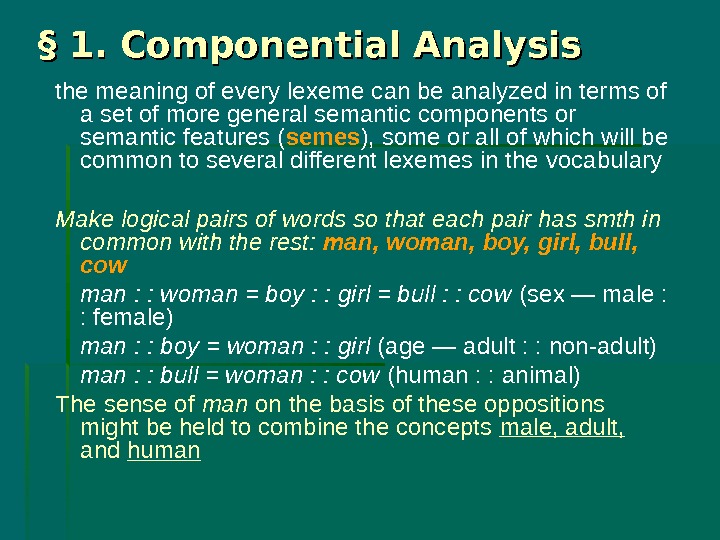


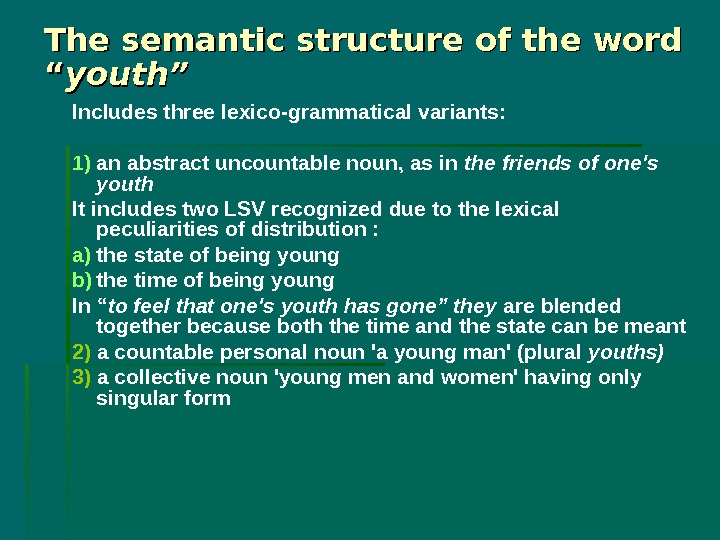



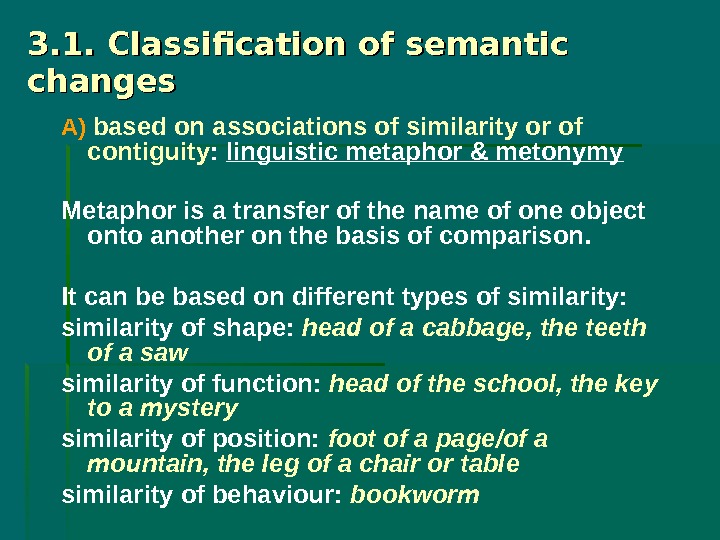

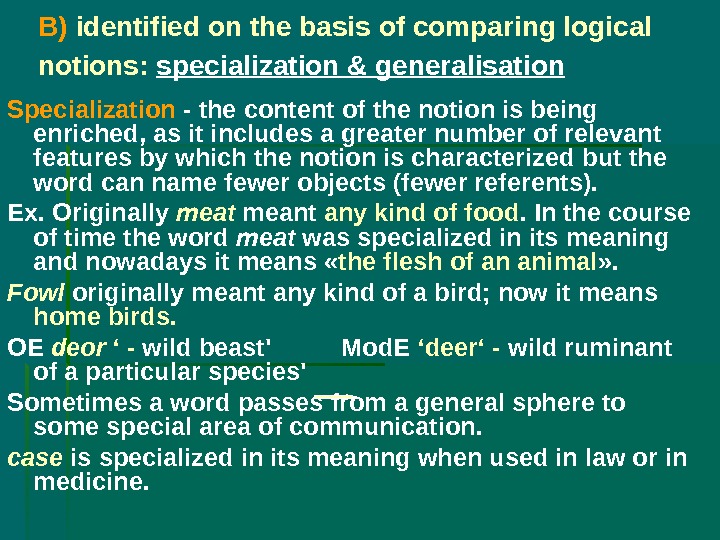




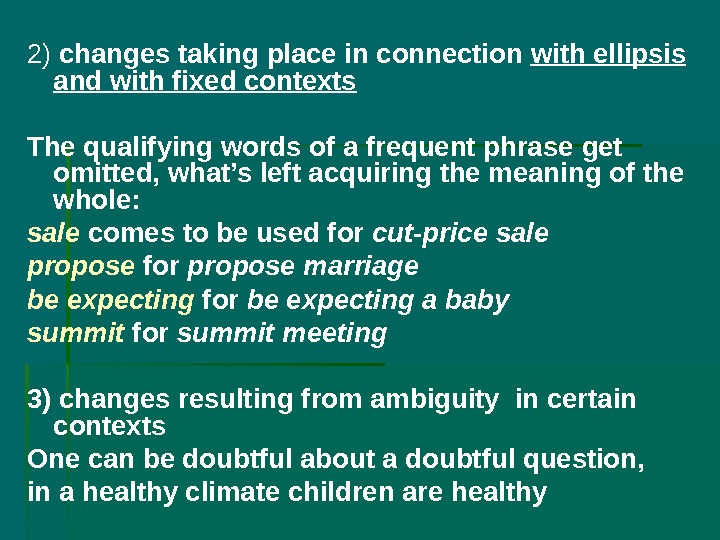


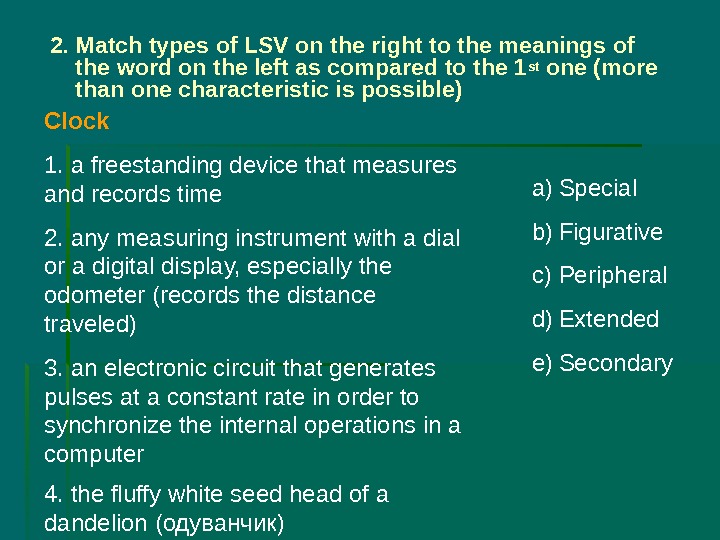


Presentation on theme: «The Analysis of Word Structure»— Presentation transcript:
1
The Analysis of Word Structure
Lecture 5 Morphology The Analysis of Word Structure
2
Morphology Words like read, language, tall, on, etc. must be learned and stored as separate items in the lexicon. However, countless other words can be constructed and comprehended by the application of some general rules. Therefore, part of the linguistic competence is the ability to construct and interpret words. This system of categories and rules involved in word formation and interpretation is called morphology.
3
Word definition Words are meaningful linguistic units that can combine to form larger structures (phrases, clauses, or sentences). A ward is associated with a particular meaning.. It is a unit of expression that is intuitively recognizable by native speakers.
4
Word identification Words are the physically definable units one encounters in a stretch of writing or speech. Words are most stable of all linguistic units, in respect of their internal structure. Words are uninterruptible.
5
Word = free form A word is the smallest free form found in language.
A free form is an element that: i can occur in isolation bird vs. -s and/or ii whose position with respect to neighbouring elements isn’t entirely fixed. Birds avoid cats. (before a verb) Cats chase birds. (after a verb) The birds (before a noun) The young birds (before something else)
6
Morpheme Concepts that are expressed by a word (free form) in one language may not necessarily have the same status in other languages: Arabic English /-/ my mother So, we need a simpler alternative.
7
Morpheme Words have an internal structure consisting of smaller units organized with respect to each other. The most important component of word structure is the morpheme. It is the smallest unit of language that carries information about meaning or function: builder = build + -er ‘construct’ ‘one who does’ houses = house + -s ‘dwelling’ ‘more than one’
8
Morphemes Free and Bound
A free morpheme can be a word by itself; it can stand alone. A bound morpheme must be attached to another element; it cannot stand alone. free bound car -s smile -ed tall -er care -ful
9
Allomorphs Morphemes do not always have an invariant form.
The variant forms of a morpheme are called its allomorphs. indefiniteness: a/an past tense: d, t, әd plural: z, s, әz
10
Word Structure Complex words consist of a root and one or more affixes. The root morpheme: i contributes the most to the word’s meaning, ii belongs to a lexical category. An affix: i does not belong to a lexical category, ii is always a bound morpheme.
11
Word Structure N V V Aff Adj Aff teach er modern ize
12
Word Structure A base is the form to which an affix is added.
It can be the root: black – en Or, it can be a larger unit: blacken – ed
13
Word Structure V black en ed Base for -ed V
Root and base Adj Aff Aff for -en black en ed
14
Structure Modification Affixation
Affixation is the most common morphological process. prefixing: inter-marry suffixing: kind-ness infixing: Aff (present) / k a t a b | / Root
15
Structure Modification Internal change
Internal change is a process that substitutes one non-morphemic segment for another: sing sang foot feet These cannot be considered as examples on infixing: i English does not have a root *sng (meaning ‘produce words in a musical tone’). ii English does not have a morpheme i meaning ‘present’ or a morpheme a meaning ‘past’ in the sing/sang case.
16
Structure Modification Suppletion
Suppletion is a morphological process whereby a root morpheme is replaced by a phonologically unrelated form in order to indicate a grammatical contrast. Basic form Suppletive form I me be were good well
17
Structure Modification Stress placement
A base can undergo a change in the placement of stress to reflect a change in its category. Verb Noun presént présent subjéct súbject contést cóntest
18
Structure Modification Compounding
It is a common morphological process which involves the combination of lexical categories to create larger words. The elements making up the compound are free forms.. Noun + Noun Adjective + Noun campsite bluebird bookcase greenhouse
19
Compounding N V Adj Adj N N V N Adj
In English, the rightmost morpheme determines the category of the entire compound. This morpheme is called the head. N V Adj Adj N N V N Adj green house spoon feed nation wide
20
Derivation Through the addition of an affix, derivation forms a word with a meaning and/or category distinct form that of its base. base derived word sell seller teach teacher i category change: verb noun ii meaning change: X someone who does X
21
Complex Derivations Since derivation can apply more than once, it is possible to create multiple levels of word structure. Verb + -ive = Adj. act + -ive = active Adj. + -ate = Verb active + -ate = activate Verb + -ion = Noun activate + -ion = activation
22
[N [V [Adj [V act] ive] ate] ion]
V Aff Aff Aff act ive ate ion
23
un-happy-ness ? (a) N (b) N Adj N Aff Adj Aff Aff Adj Aff
un happy ness un happy ness
24
un-happy-ness ? The prefix un- combines freely with adjectives, but not with nouns: unhealthy / unhealthy health + y *un + health un +healthy *unhealth + y Therefore, analysis (a) is more plausible than analysis (b).
25
Constraints on Derivation
Derivation does not apply freely to the members of a given category: i -ant combines with Latinate bases: Latinate Native defendant *fightant servant *teachant ii -en combines with monosyllabic obstruent-final base adjectives: whiten *abstracten (disyllabic) quicken *bluen (non-obstruent-final)
26
Class 1 derivational affixes
Class 1 affixes normally trigger changes in segments of the base. They usually also affect the assignment of stress. part-ial final consonant of the base changes from /t/ to /∫/ prodúct-ive stress shifts to second syllable (cf. próduct) public-ity final consonant of the base changes from /k/ to /s/, and stress shifts to second syllable (públic vs. publícity)
27
Class 2 derivational affixes
In contrast, class 2 affixes tend to be phonologically neutral, having no effect on the segmental makeup of the base or the stress assignment. prompt-ness no change triggered hair-less no change triggered hope-ful no change triggered self-ish no change triggered
28
Inflection Inflection is the modification of a word’s form.
Inflectional affixes signal grammatical relationships but do not change the grammatical class. The base to which an inflectional affix is added is the stem. The stem includes the root and all derivational affixes.
29
English Inflectional Affixes
{-s pl} noun plural {-s 3rd sg} present third person singular {-ing vb} present participle {-ed pt} past tense {-ed pp} past participle {-er cp} comparative {-est sp} superlative
30
Inflection vs. Derivation
Inflection and derivation are both marked by affixation. So, the distinction between the two processes can be subtle. It is not always clear which function a particular affix has. Three criteria help distinguish between inflectional and derivational affixes.
31
Category Change The output of inflection:
[N [N book ] s ] [V [V work ] ed ] There is no change in either the category of the base or the type of meaning it denotes. (another form of the word) The output of derivation: [N [V govern ] ment ] [N [N king ] dom ] There is a change in the category of the base and/or the type of meaning it denotes. (another word)
32
Order The derivational affix must be closer to the root than the inflectional affix. This means that the former combines with the base before the latter. N N N Aff Aff N Aff Aff neighbour hood s *neighbour s hood
33
Productivity The distribution of inflectional affixes is considerably freer than that of the derivational affixes. -ize vs. plural -s modern-ize (cf. *new-ize) legalize (cf. *lawful-ize) However, the suffix -s can combine with almost any noun that allows a plural form.
34
Summing up Morphology is concerned with the structure and formation of words in human language. Words consist of smaller formative elements called morphemes. These elements can be classified in a number of ways (free vs. bound, root vs. affix). Operations that can combine and modify morphemes include affixation, internal change, suppletion, and compounding. The two basic types of word formation in English are derivation and inflection.
35
Syntax Syntactic Data and Syntactic Rules
Constituent Order, Case Marking, and Thematic Roles Phrases and Constituent Structure
When students engage in “word analysis” or “word study,” they break words down into their smallest units of meaning — morphemes. Each morpheme has a meaning that contributes to our understanding of the whole word.
What does word analysis mean?, Word analysis is a process of learning more about word meanings by studying their origins and parts. A “morpheme” is the smallest meaningful part of a word. Other terms for word analysis: Morphemic analysis.
Furthermore, How do you analyze a word?, In “word analysis” or “word study,” students break words down into morphemes, their smallest units of meaning. Each morpheme has a meaning that contributes to the whole word. Students’ knowledge of morphemes helps them to identify the meaning of words and builds their vocabulary.
Finally, What is analysis of word structure?, Structural analysis is the process of breaking words down into their basic parts to determine word meaning. … When using structural analysis, the reader breaks words down into their basic parts: Prefixes – word parts located at the beginning of a word to change meaning. Roots – the basic meaningful part of a word.
Frequently Asked Question:
How do you teach the word meaning?
How to teach:
- Introduce each new word one at a time. Say the word aloud and have students repeat the word. …
- Reflect. …
- Read the text you’ve chosen. …
- Ask students to repeat the word after you’ve read it in the text. …
- Use a quick, fun activity to reinforce each new word’s meaning. …
- Play word games. …
- Challenge students to use new words.
How do you understand words meaning?
To understand a word without a dictionary, try re-reading the entire sentence to see if the context helps you to find out what the word means. If it’s unclear, try to figure it out by thinking about the meaning of the words you’re familiar with, since the unknown word might have a similar meaning.
How do you teach word concepts?
The first step with Concept of Word Instruction is to teach the poem to the students. They need to have the poem memorized, so that they can accurately match the memorized words to the print they see. Teachers can use pictures that represent the text or hand motions with common nursery rhymes and finger plays.
How do you teach words with multiple meanings?
Play word games that ask students to recognize words‘ multiple meanings. For example, create—or have students illustrate—pairs of cards to tell or show two meanings of a specific word. Use the cards to play a matching game. Students should collect both pictures for a word and give a verbal definition of each picture.
How can we help students to understand meaning?
Follow these steps and try some different techniques in your classroom:
- Choose a lesson from your textbook. …
- Before the lesson, select some words that you think your students won’t know. …
- Decide how you could help your students understand these words. …
- Before your students read the lesson, write the words on the board.
What does structural analysis mean?
STRUCTURAL ANALYSIS is a strategy that is used to facilitate decoding as students become more proficient readers. These advanced decoding strategies help students learn parts of words so they can more easily decode unknown multi-‐syllabic words. In structural analysis, students are taught to read prefixes and suffixes.
What is structure in structural analysis?
1.1 Structural Analysis Defined. A structure, as it relates to civil engineering, is a system of interconnected members used to support external loads. Structural analysis is the prediction of the response of structures to specified arbitrary external loads.
What is word analysis?
When students engage in “word analysis” or “word study,” they break words down into their smallest units of meaning — morphemes. Each morpheme has a meaning that contributes to our understanding of the whole word.
What are the types of structural analysis?
What are the types of Structural Analysis?
- Hand Calculations. Hand Calculations in Structural Analysis. …
- Finite Element Analysis. Finite Element Analysis (FEA) …
- Structural Analysis Software.
What is structural analysis of words?
Structural analysis is the process of breaking words down into their basic parts to determine word meaning. … When using structural analysis, the reader breaks words down into their basic parts: Prefixes – word parts located at the beginning of a word to change meaning. Roots – the basic meaningful part of a word.
How do I teach word study?
A cycle of instruction for word study might include the following:
- introduce the spelling pattern by choosing words for students to sort.
- encourage students to discover the pattern in their reading and writing.
- use reinforcement activities to help students relate this pattern to previously acquired word knowledge.
How do you teach the word meaning?
How to teach:
- Introduce each new word one at a time. Say the word aloud and have students repeat the word. …
- Reflect. …
- Read the text you’ve chosen. …
- Ask students to repeat the word after you’ve read it in the text. …
- Use a quick, fun activity to reinforce each new word’s meaning. …
- Play word games. …
- Challenge students to use new words.
What are some strategies for breaking words apart to get their meaning?
5 Ways To Have K-2 Students Practice Breaking Apart Words
- Segment the sounds in a CVC (consonant-vowel-consonant) word.
- Read the onset and rime of a word (i.e. sh-ip)
- Recognize and read word families.
- Read “smaller” words inside compound words.
- Derive meaning from root words, prefixes, and suffixes.
What is word analysis?
When students engage in “word analysis” or “word study,” they break words down into their smallest units of meaning — morphemes. Each morpheme has a meaning that contributes to our understanding of the whole word.
How do you analyze a word?
In “word analysis” or “word study,” students break words down into morphemes, their smallest units of meaning. Each morpheme has a meaning that contributes to the whole word. Students’ knowledge of morphemes helps them to identify the meaning of words and builds their vocabulary.
What is analysis example?
The definition of analysis is the process of breaking down a something into its parts to learn what they do and how they relate to one another. Examining blood in a lab to discover all of its components is an example of analysis. noun.
What is Analysis sentence?
The purpose of analysis is to make the complete grammatical structure of a sentence clear. Each part of the sentence is identified, its function des- cribed, and its relationship to the other parts of the sentence explained. There are different ways of presenting a sentence analysis.



























